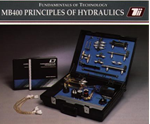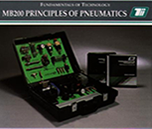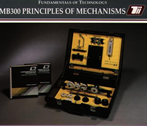TII’s instructor-developed curriculum is flexible and features 25 to 30 hours of instruction in hydraulic components, pneumatics components, and mechanical devices, applications and principles. The modular format allows self-teach/self-paced or group instruction. The Physical Properties section combines science and technology as in programs like the Principles of Technology.
Each lesson requires trainees to conduct an experiment in hydraulic technology using one or more of the 18 industrial-grade hydraulic components, including different types of valves, cylinders and measuring instruments. In the Application Laboratories section of the manual, trainees use the components to emulate industrial applications. A complete power supply with a pump and fluid reservoir, together with a work surface and the components conveniently stored on a panel, provide everything needed to understand this fluid power technology. The pump is designed to operate at approximately 25 PSI for safety.
Each lesson requires students to conduct an experiment in pneumatic technology using one or more of the 22 industrial-grade pneumatic components, including different types of valves, cylinders and measuring instruments. In the Application Laboratories section of the manual, students use the components to emulate industrial applications. A complete power supply with compressor, together with a work surface and the components conveniently stored on a panel, provide everything needed to understand this fluid power technology. The compressor is limited to 60 PSI for classroom safety.
Each lesson includes an experiment that requires trainees to construct and operate a simple machine or device for transmission of power, followed by a quiz to reinforce concepts and measure competency. Among the 30 mechanical components are a variety of gears, pulleys and assemblies. In the Application Laboratories section of the manual, trainees use the components to design their own solutions to meet common problems that occur in industrial and everyday situations. Trainees will understand and visualize the basic elements found in simple to complex machines.
Each kit includes:
- 3 Pneumatic Kits
- 4 Hydraulics Kits
- 2 Mechanics Kits


